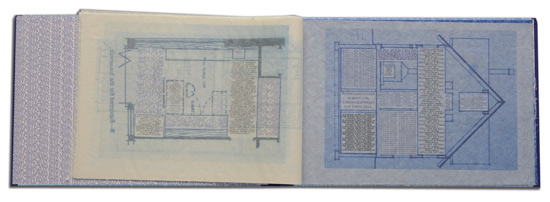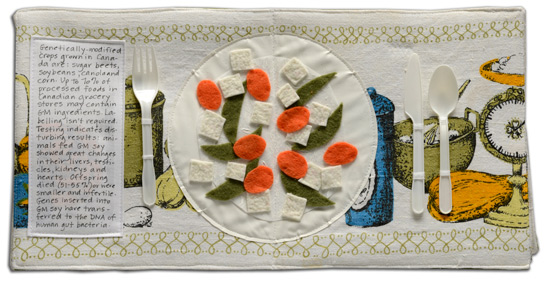 |
By the simplest means – elemental shapes cut from felt – Lise Melhorn-Boe has conjured up a homey, old-timey repast in her book, What’s for Dinner? Her uniquely constructed, table-top sized book unfolds section by section to reveal a brightly colored pop-up meal set out on what seems a charming vintage table cloth. This playful banquet seems to capture the essence of wholesome living in which a rich bounty of good food makes for happy times and happy memories.
But a shadow is cast over this delightful scene. Melhorn-Boe turns a culinary tale into a cautionary tale. Next to an ostensibly nutritious stir-fry meal of carrots, snow peas, and tofu is a napkin with a hand-written message that tells |
another, not so wholesome, story about genetically-modified soy and its many dire consequences. Another napkin, this one accompanying a plateful of delectable-looking salad greens and bright slices of tomato, lets us know that a full half of the produce in America’s grocery stores contains pesticides, and that soon most of us will have measurable amounts running through our bloodstreams. Melhorn-Boe is artful in the way she sets up the healthful and delicious against the dangerous and deadly. The narrative of What’s for Dinner? advances along two parallel paths, thereby serving up a succinct commentary on the pleasures and dangers of eating in America.
What’s for Dinner?
Lise Melhorn-Boe |
|
 |
|
Another kind of deception appears in Silverberg’s Home Sweet Home. What seems to be before us is a blueprint of the ground plan and elevation of a typical American house. It’s actually a printed imitation. The artist has carefully simulated the particular wan blue, along with the slightly blurred edges, of the now-antiquated Diazo technique. Like Testament Textiles, words are on prominent display, offering a welter of cross-cultural proverbs, aphorisms and quotes on the nature of womanhood. |
Here, however, instead of being laid out in strips, sentences are packed tightly within the rectilinear room divisions of the pseudo-blueprint, lending the pages a busy, chattering presence, hemmed in – imprisoned, perhaps – by the insistent geometry of the house. Metaphorically, Silverberg’s home becomes a limiting container for women’s lives, a visual reflection of the often horribly misguided or outrightly hateful words placed within.
Home Sweet Home
Robbin Ami Silverberg |
